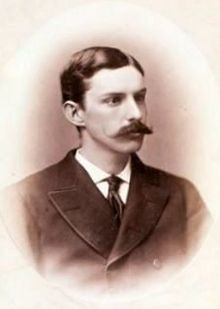George Howard Monks
George Howard Monks (born March 28, 1853 in Boston , died January 6, 1933 there ) was an American surgeon and game inventor . He was a professor at Harvard Medical School and the Harvard School of Dental Medicine and dealt mainly with plastic and oral and maxillofacial surgery ; he also researched the anatomy of the intestine . He was also known as the inventor of the Halma game .
life and work
Family and education
George Howard Monks was born in 1853 to John P. Monks and his wife Delia S. Monks, née Hatton. He attended the Boston Latin School before going to college. In 1875 he graduated from Harvard College and then moved to the architecture department at the Massachusetts Institute of Technology , where he studied for a year. He then decided to study medicine and moved to Harvard Medical School , where he graduated with an MD in 1880 . He completed a one-year internship in surgery at the Massachusetts General Hospital before studying for four years in Europe, including in Vienna , Leipzig , Heidelberg and Paris . After this time he was accepted into the Royal College of Surgeons of England in London .
Monks married Olga E. Gardner in 1897, with whom he had three children: Reverend George Gardner Monks, principal of the Lenox School in Boston, John Peabody Monks, who worked as a doctor in Boston, and his daughter Olga Monks. Monk's sister Luisa Delia (1848–1910) was married to the Dresden chemist Walther Hempel .
Medical career
In 1884, Monks began his work as a general surgeon in Boston and was assigned as a district doctor by the Boston Dispensary , and later became a doctor at Carney Hospital . In 1890 he began his work at Boston City Hospital , where he became chief physician in 1910. In 1914 he resigned as chief physician and only worked as an advisory surgeon. From 1886 to 1914 he was a lecturer at the Harvard Medical School, where he gave courses in surgery, and until 1926 at the Harvard School of Dental Medicine , where he was an important bridge between the medical and dental schools in these 40 years and ended up being professor of oral surgery. In 1926 he also retired from the Dental School .
During his time as a surgeon at Harvard Medical School Monks worked mainly in the field of facial and oral surgery . He described operations to correct ear deformities and plastic correction of the nose, the removal of the larynx after cancer, the treatment of spiral fractures of the thigh and other techniques. He also worked as an anatomist , mainly on the anatomy of the intestine, the exact location of which he described on the basis of numerous studies on the deceased and, based on this, developed surgical techniques for the small intestine .
Monks has served on multiple occasions as chairman, secretary, and president of the Suffolk District Medical Society's surgical section, as well as president of the Boylston Medical Society and vice-president of the American Surgical Association . He was also a member of the American Medical Association , the American College of Surgeons, and President and founding member of the Boston Surgical Society . He was also a senior member of the New England Surgical Society and President of the Boston Medical Library , the Boston Society of Medical Sciences, the Massachusetts Medical Society, and the Boston Society for Medical Improvement.
Invention of the game of straws and other hobbies

In addition to his medical career, Monks invented the straw game in 1883 while studying in Paris . He was visiting his brother Robert and preparing for admission to the Royal College of Surgeons. The game was first propagated by Robert's father-in-law, the Harvard president and mathematician Thomas Hill, who also invented the name Halma, after the ancient Greek ἅλμα "jump". The game was later distributed in the United States by Thomas Smith and is now considered a classic board and strategy game. In 1890, another board game from Monks, Basilinda , appeared , which is very similar to the Halma game.
Monks was also a hobby artist and created some sculptures that were also exhibited at various art exhibitions for amateurs. Among other things, he created a bust of George Augustus Peabody , which was later enlarged and made in marble for display in the Peabody Essex Museum in Salem and as a replica in the Peabody Institute in Danvers .
Individual evidence
- ↑ a b c d e f g F. B. Lund: Memoir: George Howard Monks, MD, 1853-1933. In: Annals of surgery. Volume 97, Number 6, June 1933, pp. 959-962, PMID 17866997 , PMC 1391902 (free full text)
- ^ Entry on Hempel in the DB
- ^ The history of Halma , Chinese Checkers. Retrieved April 9, 2016.
- ↑ Game of Basilinda for children . Game Archives.
| personal data | |
|---|---|
| SURNAME | Monks, George Howard |
| BRIEF DESCRIPTION | American surgeon, oral surgeon and game inventor |
| DATE OF BIRTH | March 28, 1853 |
| PLACE OF BIRTH | Boston |
| DATE OF DEATH | January 6, 1933 |
| Place of death | Boston |
